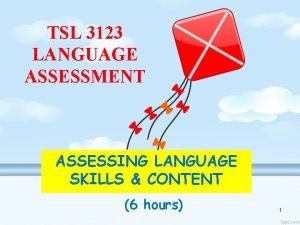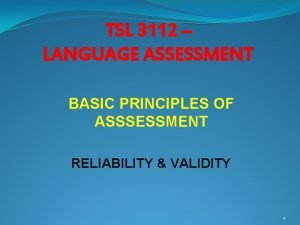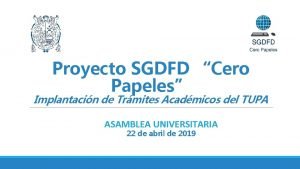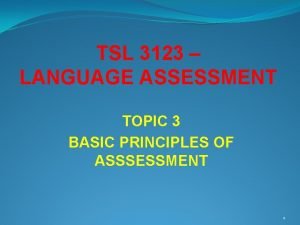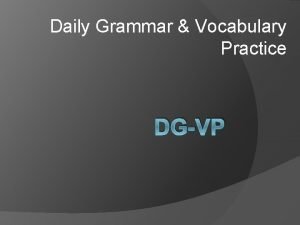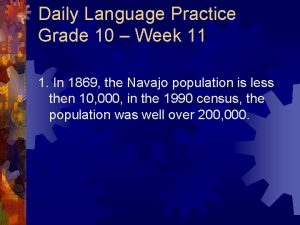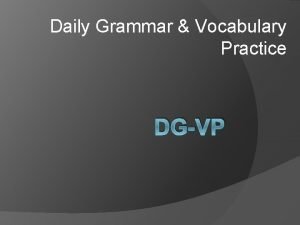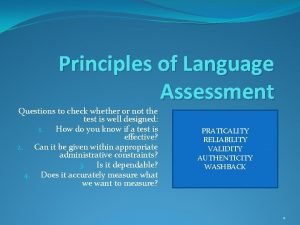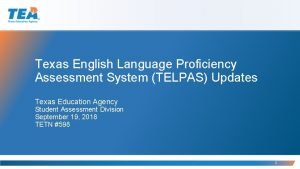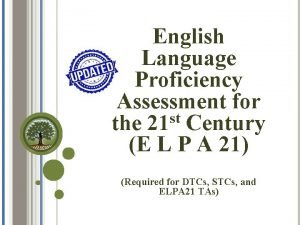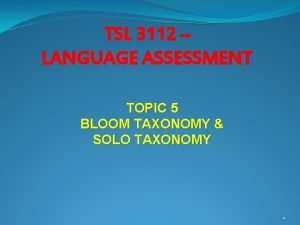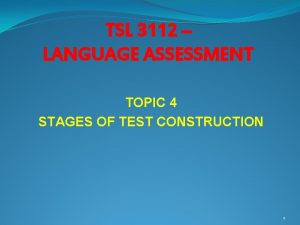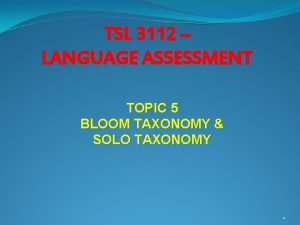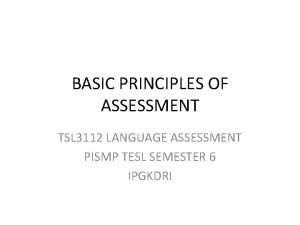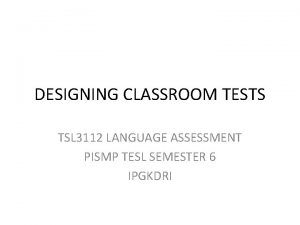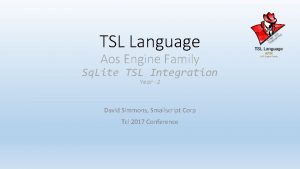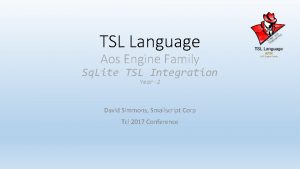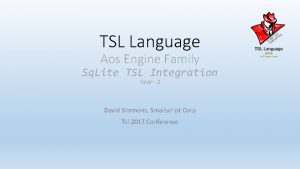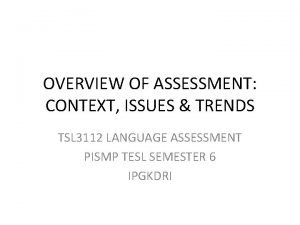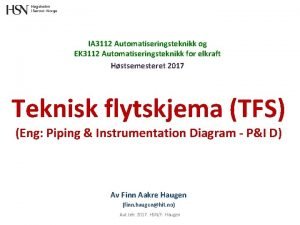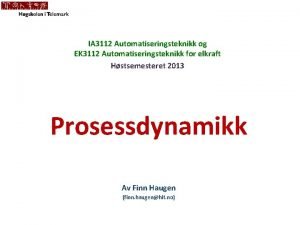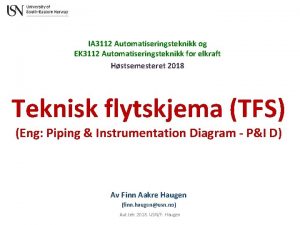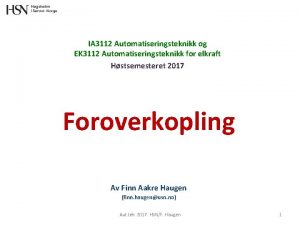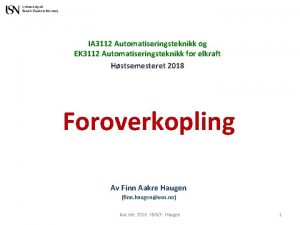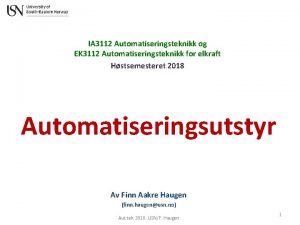TSL 3112 LANGUAGE ASSESSMENT WEEK 1 TOPIC 1
























- Slides: 24

TSL 3112 – LANGUAGE ASSESSMENT WEEK 1 – TOPIC 1 OVERVIEW OF ASSESSMENT: CONTEXT, ISSUES AND TRENDS 1

TERMINOLOGY �Assessment: The process of gathering information to make informed decisions. �Test: An instrument or systematic procedure for measuring a sample of behaviors by posing a set of questions in a uniform manner. �Measurement: Process of obtaining a numerical description of the degree to which an individual possesses a particular characteristic. �Evaluation : refers to the process of making judgments, assigning value, or deciding worth. 2

ASSESSMENT In educational practice assessment: § refers to the full range of information gathered and synthesized by teachers about their students and their classrooms. § is a continuous process and is tied to instruction. § can be gathered through • informal means such as through observation and verbal exchange. • formal means such as homework, tests and written reports, 3

ASSESSMENT �All situation included over time �An on-going process �Includes multiple samples of behavior, not just one single judgment or test 4

TESTS �Test: An instrument or activity used to accumulate data on a person’s ability to perform a specified task. �A subset of assessment (a genre of assessment technique) 5

ASSESSMENT VS. TESTING �Testing is assessment, assessment is not testing �Assessment should be ongoing 6

CONTENTS �Why tests? �Problems of many tests �Quality of a good test �History of different approaches �Comparison: measurement, test, evaluation, and assessment �Relationship between measurement, test, evaluation, and assessment �Homework 7

WHY TESTS? �Achievement of learners �Selection among competitions �Comparison for levels/ranking �Examination/Evaluation on teaching methods �Betterment of tests �Pressure on professionals 8

OTHER USES OF TESTS �Motivation �Achievement �Improvement �Diagnosis �Prescription �Grading �Classification �Prediction 9

PROBLEMS OF MANY TESTS �Poor Reliability �Poor Validity �Not Practical �Negative Backwash • Backwash: the effect of testing on teaching and learning 10

QUALITY OF A GOOD TEST A Good Test should … �be valid �be reliable �be practical �have beneficial backwash 11

QUALITY OF A GOOD TEST A test is said to be : � reliable when it produces dependable results consistently. � valid when it measures what it claims to measure. � fair if it offers all students the same chance to doing well and if it does not discriminate against a particular group of students because of race, ethnicity, or gender. 12

HISTORY OF DIFFERENT APPROACHES 1. The Essay Translation Approach 2. The Structuralist Approach 3. Integrative Approach 4. Communicative Approach 13

THE ESSAY TRANSLATION APPROACH �Also called Grammar-translation Approach �Before 1950 s �Pre-scientific: required no special expertise in testing; based on T’s intuition & experience �Subjective �Testing = Art �Anyone can make a test. �Not reliable 14

THE STRUCTURALIST APPROACH �Also called Psychometric Structuralist Approach �Early 1950 s - late 1960 s �Decontextualized, discrete-point tests �Tries to include more samples of the test taker’s ability at the same time �Testing = Science (objective & reliable) �Test one single area at a time �Emphasis: form & structure �Standard Format—Multiple-Choice 15

INTEGRATIVE APPROACH � 1970 s – early 1980 s �Under the influence of psycholinguistics and sociolinguistics �Testing of language in context �May test more than one skill at a time (e. g. , cloze) �Emphasis: meaning 16

COMMUNICATIVE APPROACH � 1980 s – NOW �Emphasis: language use—how people use language for different purposes �Uses authentic materials from the real life �Has to use language both accurately and appropriately 17

Measurement and Evaluation 18

MEASUREMENT �Quantifies the characteristics (both physical and mental) of persons �Examples: height, motivation, aptitude �Involves both tests and non-tests 19

MEASUREMENT �A measurement takes place when a “test” is given and a “score” is obtained. �If the test collects quantitative data, the score is a number. �If the test collects qualitative data, the score may be a phrase or word such as “excellent. ” 20

EXAMPLE: TEST �Reading/writing tests �A procedure designed to get specific samples of a person’s ability �A measurement instrument 21

EVALUATION �Evaluations are either formative or summative. �It can be: �Quantitative �Numbers involved; e. g. , scores or �Qualitative �Analyze data; e. g. , letters of reference �Systematic gathering of information for decision making �Determination of adequacy 22

SUMMARY Assessment Measurement (non-test) (test) Evaluation 23

HOMEWORK �Read Chapter One �Read Handout One: �Brown, J. D. Testing in Language Programs. NJ: Prentice Hall Regents, 1996. (pp. 2 -15) 24
 Tsl success trading sdn bhd
Tsl success trading sdn bhd Tsl success trading sdn bhd
Tsl success trading sdn bhd Tsl co ltd
Tsl co ltd Implantacion
Implantacion What is tsl in trading
What is tsl in trading Week by week plans for documenting children's development
Week by week plans for documenting children's development Clincher sentence
Clincher sentence Broad and specific topic examples
Broad and specific topic examples Authenticity principles of language assessment
Authenticity principles of language assessment Topic 1 assessment
Topic 1 assessment Topic 8 assessment
Topic 8 assessment Topic 10
Topic 10 Topic 2 assessment
Topic 2 assessment Greek or latin root/affix mon-to warn
Greek or latin root/affix mon-to warn Daily language review week 18 answers
Daily language review week 18 answers Did you see big
Did you see big Paranoia in a sentence
Paranoia in a sentence Daily language review week 11 answer key
Daily language review week 11 answer key Dgp sentences 7th grade answers
Dgp sentences 7th grade answers Principle in portfolio assessment
Principle in portfolio assessment Define dynamic assessment
Define dynamic assessment Portfolio assessment matches assessment to teaching
Portfolio assessment matches assessment to teaching Principles of language testing
Principles of language testing Telpas 4 point speaking rubric
Telpas 4 point speaking rubric English language proficiency assessment (elpa)
English language proficiency assessment (elpa)
